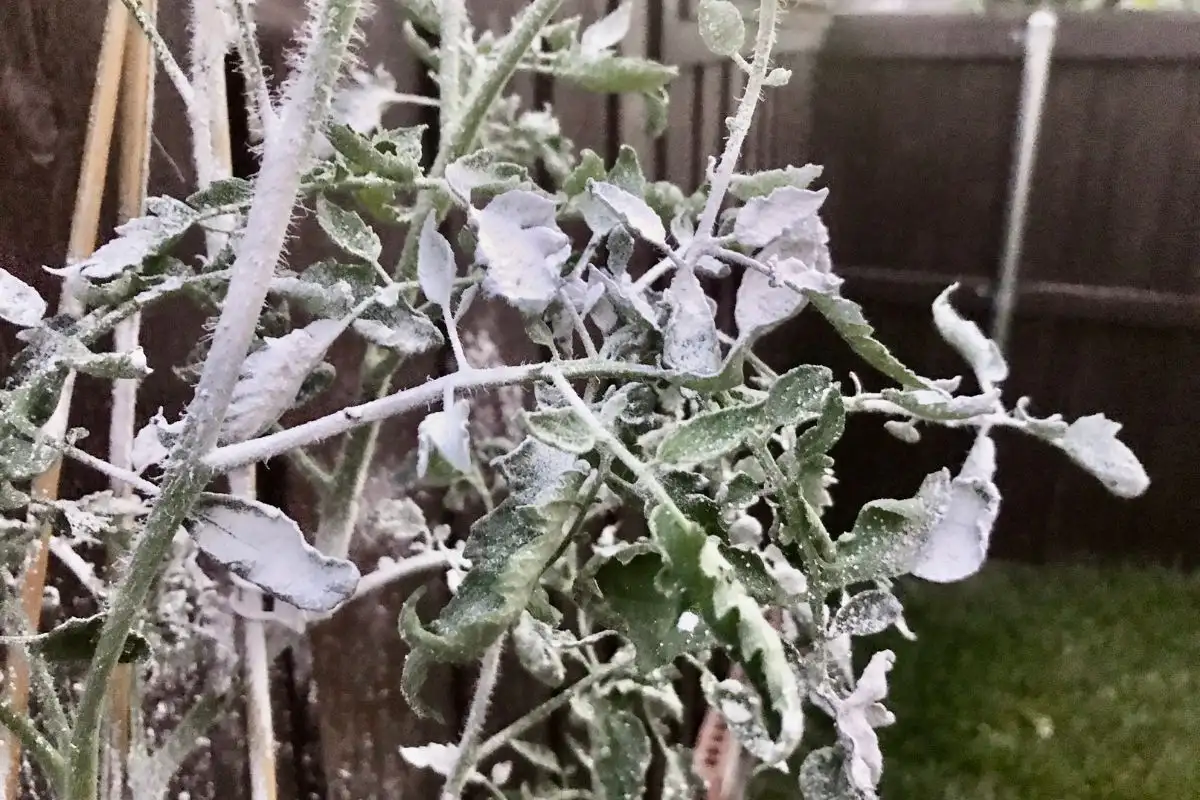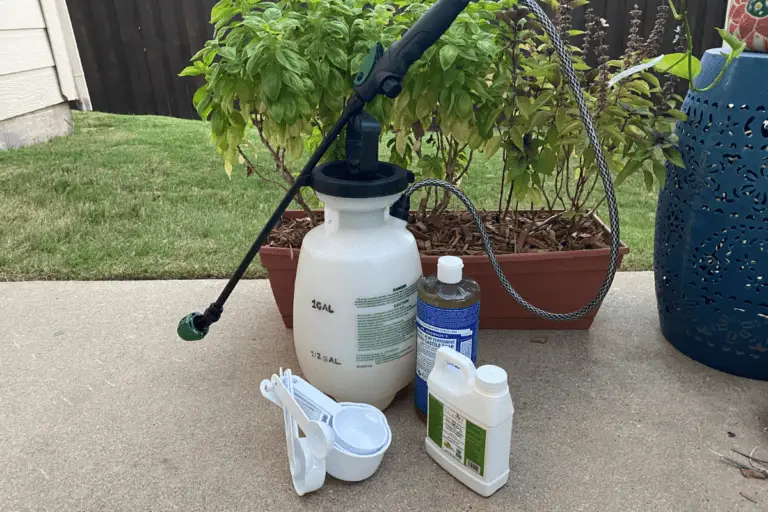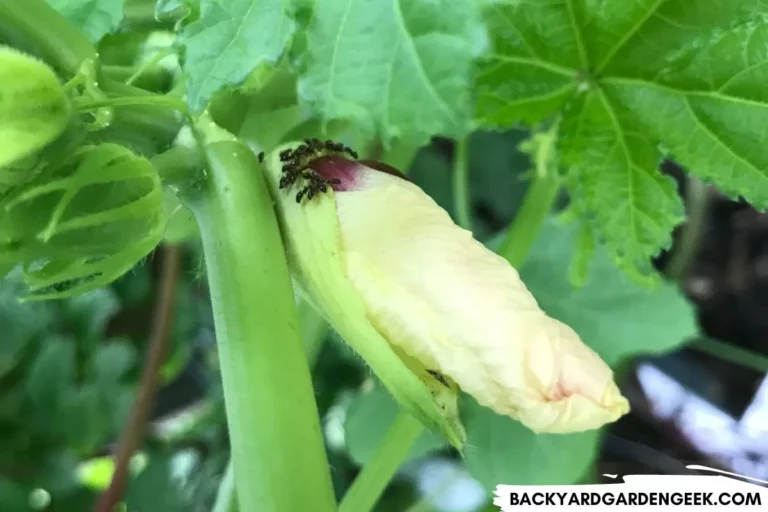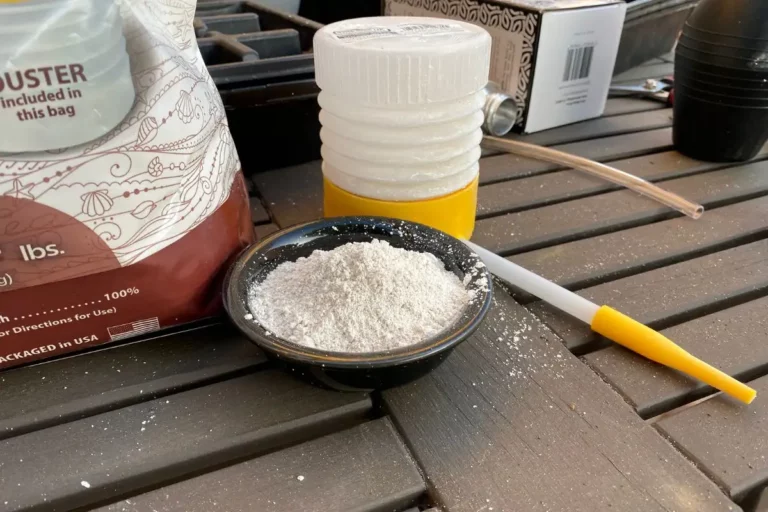Can You Put Too Much Diatomaceous Earth on Plants?
Over the past few years, I’ve often turned to diatomaceous earth (DE) to control certain pests and protect my plants. It’s a natural, organic product that can be effective against a variety of insects, including aphids, flea beetles, mealybugs, and spider mites.
However, when I first started using it in my garden, I had heard concerns about using too much diatomaceous earth and potentially causing problems, which made me wonder: Can I put too much DE on my plants? What’ll happen if I do?
Adding too much diatomaceous earth (DE) to a garden can theoretically stunt plant growth even though DE is a safe, organic way to control pests and amend hard clay or saline soils. Too much DE can potentially kill off beneficial insects, clog plant stomata, and negatively affect soil drainage.
In this article, I’ll look at whether or not DE can hurt your plants and share insights into what DE is and how exactly it works in your garden.
Here’s what I’ll be covering:
- what happens if you cover your plants in too much DE
- recommendations for using DE properly in your garden
- overview of what DE is and how it works (for anyone who’s unfamiliar with it)
Whether you’ve used DE in your garden or not, this article will give you all the insights you need to determine whether DE is right for you and your plants.
What Happens If You Use Too Much Diatomaceous Earth?
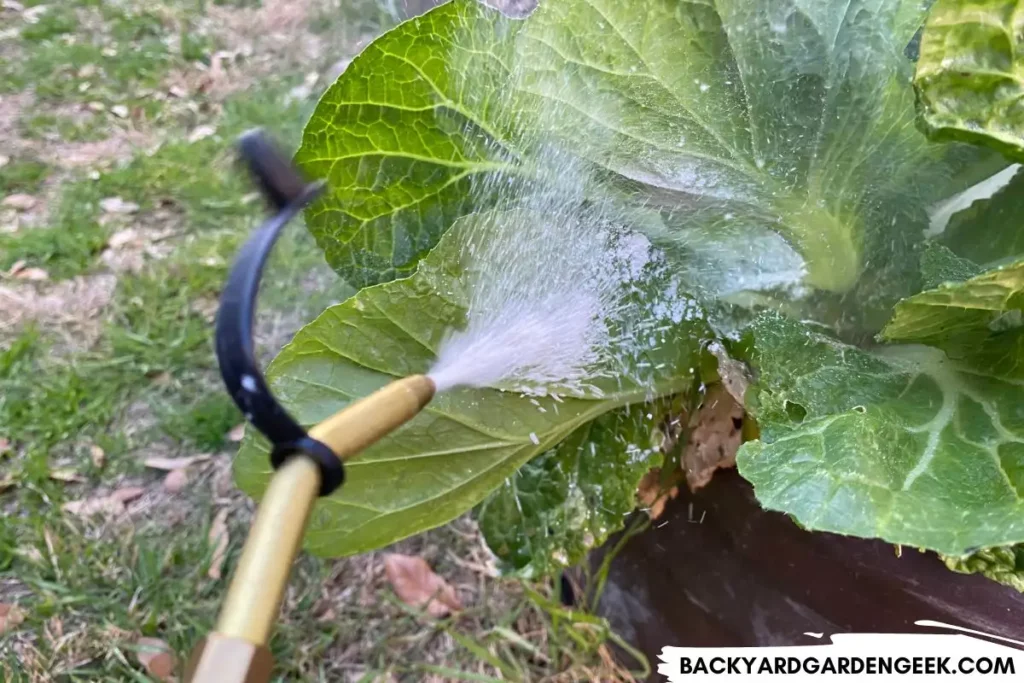
Diatomaceous earth is generally considered safe for plants, but like many things in the garden, you’ll want to use it in moderation since the goal is to control pests and amend soil, not nuke your natural ecosystem!
So let’s look at the various ways that DE can theoretically harm your plants, then examine how you can avoid these scenarios by using DE in ways that are safe for your plants and soil.
The amount of DE that’s too much for plants varies depending on several factors, such as the type of plant, the severity of the pest infestation, and the frequency of application.
As a general rule, I recommend going easy at first to make sure your plants like what you’re doing—a light layer of dust on pest-infested plants or small amounts added to soil that’s not draining well or has too much clay in it.
When it comes to the science behind DE, there’s not much in the way of guidance when it comes to overuse. Here’s what I’ve found in the recent literature:
- This study suggested that the overuse of DE could decrease a plant’s ability to produce chlorophyll.
- However, these researchers actually found that DE applications increased chlorophyll levels by stopping bugs from feasting on the plants. It said nothing about possible overuse of DE.
- This paper also showed that chlorophyll levels increased when using DE since it stopped a pest infestation.
- This study argued that proper use of DE increased photosynthesis since it stopped the destruction caused by pests.
Simply put, there’s almost no scientific evidence about DE harming plants or anything (that I’ve seen so far) that suggests that you can overdo it with DE and thus hurt your garden in the process.
But anyone who knows anything about gardening understands that we need to learn from our personal experiences and also use common sense when it comes to what we treat our plants and soil with.
With that in mind, here’s what I’ve learned from the years I’ve used DE in my garden, followed by some recommendations for using DE in ways that your plants and soil will love.
First, the things to avoid:
1. Coating Plants in Too Much DE
While DE is an effective natural pesticide, covering your plants with it can theoretically have negative consequences.
If you coat the plant in DE, there’s a chance that the powder will clog the plant’s stomata—the little pores on the plant that allow it to exchange oxygen and carbon dioxide—thus preventing your plant from breathing properly.
Without proper respiration, your plants could suffer from yellowing, wilting, or stunted growth.
I recommend using DE in moderation and following the instructions on the bag carefully.
My one exception to this rule is flea beetles. If you’ve got flea beetles on your plants, you’re in trouble since these little pests will withstand both soapy water and neem oil sprays.

As you can see in the photo above, I had a tomato plant that was overrun with flea beetles. Because of that, I dusted the entire plant with DE. I didn’t want to do that, but it was either cover everything in DE or lose the plant (and possibly other nearby plants) to flea beetles.
- The bad news: It took my tomato plant several weeks to recover from the infestation and DE dusting.
- The good news: The DE knocked out my flea beetle infestation, and the tomato plant survived and kept producing tomatoes for me.
Under normal conditions, a thin layer of DE is usually enough to control pests without harming your plants. If you notice any signs of plant damage, such as yellowing leaves or stunted growth, go ahead and rinse the DE off your plants and reduce the amount of DE you’re using in your garden.
2. Spreading Too Much DE Across Your Garden
While DE is an effective natural pesticide against unwanted pests, using too much of it can negatively impact the native bug populations in your garden, especially the beneficial bugs.
Beneficial insects such as butterflies, lacewings, ladybugs, parasitic wasps—and even ants (the non-stinging kind), pill bugs (or roly-polies, as they’re sometimes called), and many other bugs—play an important role in maintaining the overall health of your garden ecosystem.
Unfortunately, if you coat your garden plants with too much DE, these beneficial bugs can be killed off in the process since the overuse of DE can disrupt the balance of your garden’s ecosystem.
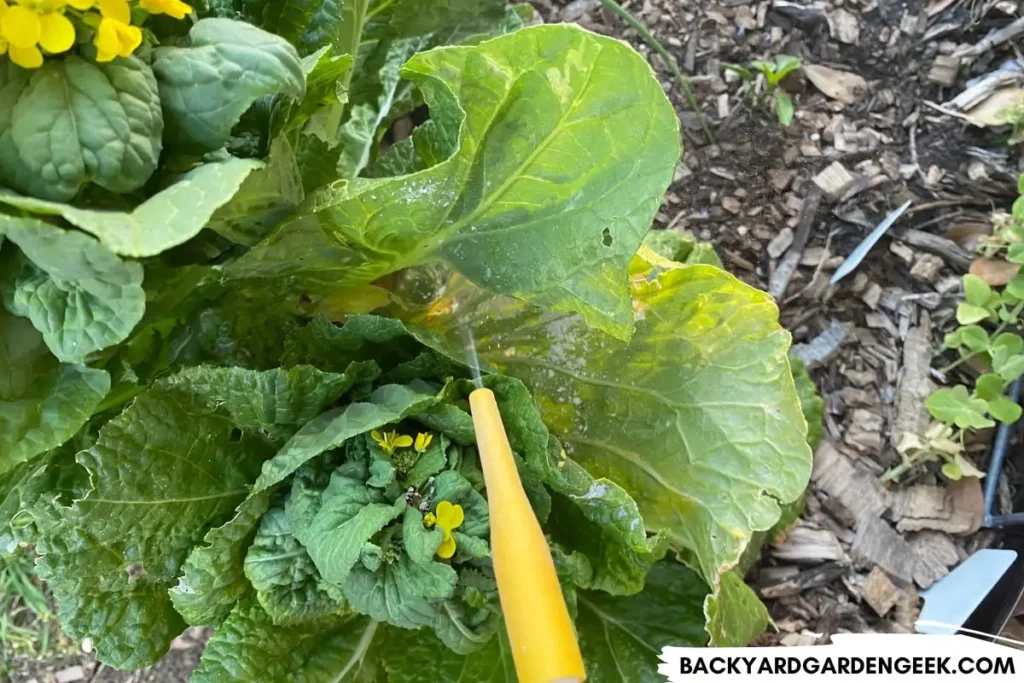
While it’s important to control pests, it’s equally important to be mindful of the impact your methods have on the overall health of your garden.
3. Applying DE When There’s Rain in the Forecast
While diatomaceous earth is a great natural pest control solution, you need to use it at the right time and in the right conditions.
One situation to avoid is using DE right before it rains. When DE gets wet, it becomes less effective as a pest control solution, and it also gets gross and clumpy, forming a layer of residue atop your plants that does nothing to protect them from garden pests.
This is why you need to keep an eye on the weather and only use DE at the right time and in the right amounts.
Is rain in the forecast? If so, keep that DE in your garage or shed and wait until the rain’s passed to spread it on your plants.
4. Adding Too Much DE to Your Soil
I’ve written about adding diatomaceous earth as a soil amendment, and generally speaking, DE can help out in several ways:
- DE can enhance the structure of your soil.
- DE can improve your soil’s ability to retain water and drain well.
- DE can increase nutrient availability by helping plants uptake your soil’s nutrients.
- DE can provide essential minerals to your plants.
But if you incorporate too much DE into the soil, you might cause some unintentional problems in your garden.
Since DE is rich in silica and also highly absorbent, you can alter the way your soil drains, so I recommend starting small when it comes to soil amendments: Begin by using 8 ounces (or around .25 liter) of DE per 25 square feet of soil in your garden.
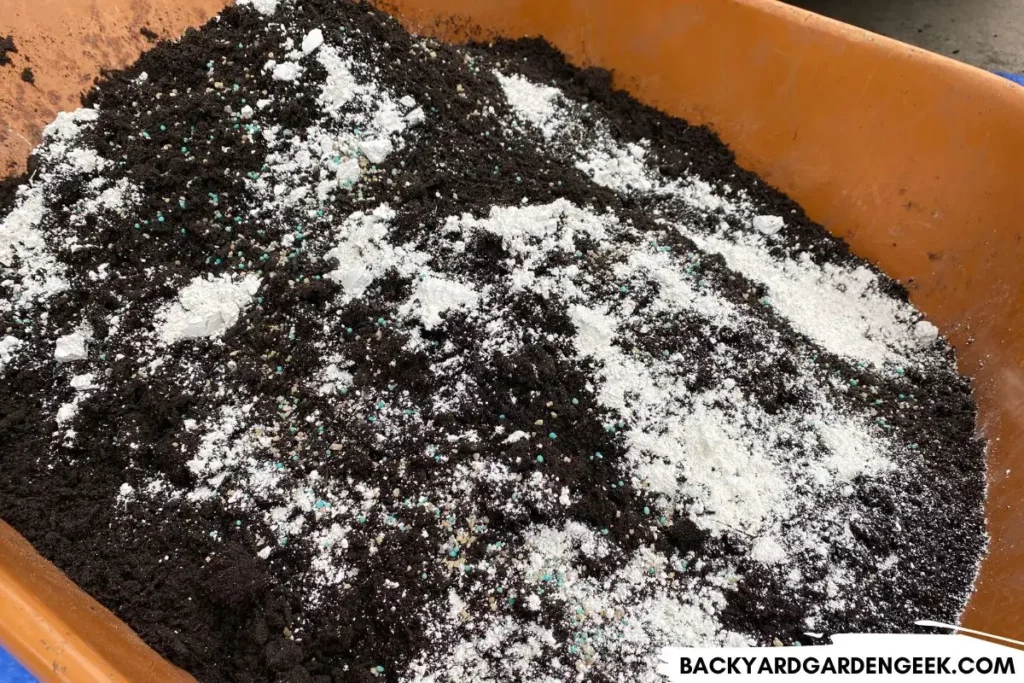
I don’t want you to overdo things and possibly stunt the growth of your plants. To avoid harming the plant roots, use DE sparingly and avoid adding too much to any one part of your garden.
Even better, try amending some of your soil with DE and watch to see what happens this growing season. If you notice your plants thriving in that area, you might want to add DE elsewhere in your garden.
You should mix the diatomaceous earth into the soil (instead of applying it on top) to prevent it from forming a thick layer on the surface that’ll get somewhat clumpy after you water your plants.
And remember: Always use “food-grade” DE. This type of diatomaceous earth is safe for consumption and will not harm plants or animals when used properly. Filter-grade diatomaceous earth, on the other hand, should not be used in your garden since it may contain chemicals and contaminants that’ll harm your plants.
What is Diatomaceous Earth?
Diatomaceous earth (DE) is made up of the fossilized remains of diatoms, a type of single-celled algae.
You’ll typically find these diatoms in oceans, rivers, and lakes. When they die, their microscopic shells settle to the bottom and eventually fossilize. The resulting rock is then mined and ground into a fine powder, which feels much like flour.
DE is composed of a hard, crystalline silica structure, which makes it abrasive to insects, although smooth as flour to humans and pets.
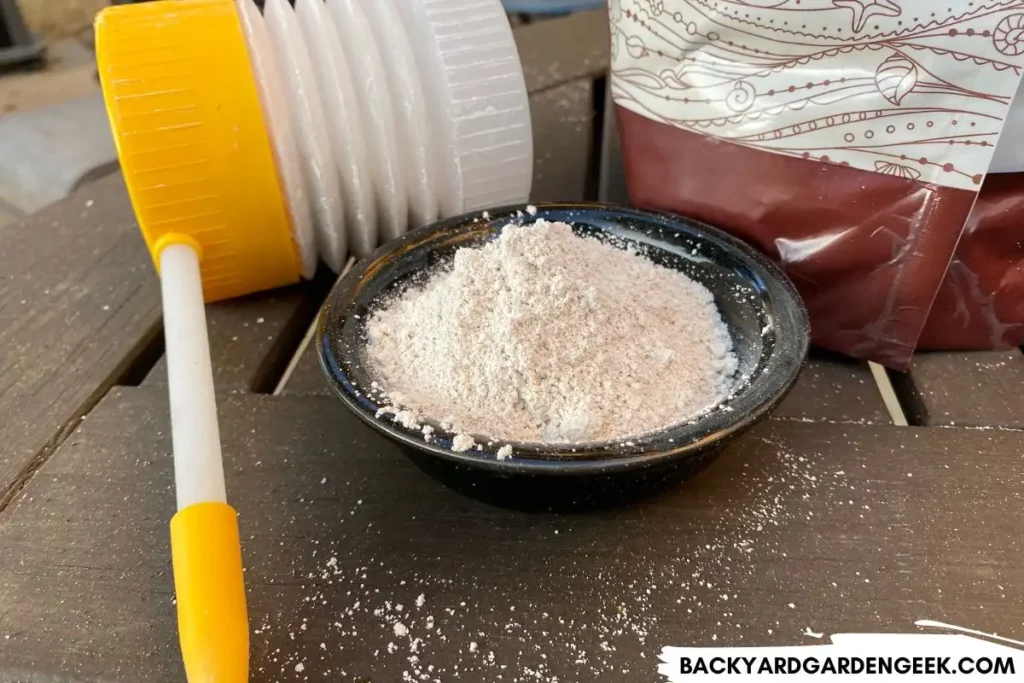
When insects come into contact with DE, the powder sticks to the insect’s body and dehydrates it by absorbing the oils and fats from its exoskeleton. Additionally, the sharp edges of the diatoms cut into the insect’s exoskeleton, speeding up the process of dehydration and death.
You’ll find two main types of DE if you go searching for it online: food-grade and filter-grade.
From what I’ve seen, food-grade DE is safe for human and animal consumption and is often used as a dietary supplement to promote healthy skin, hair, and nails.
(But of course, please consult a medical specialist before ingesting any DE!)
Unlike food-grade DE, filter-grade DE is used in industrial applications, such as water filtration, and is not safe for consumption.
Here’s a table comparing food-grade and filter-grade diatomaceous earth:
| Property | Food-Grade DE | Filter-Grade DE |
|---|---|---|
| Purity | High | May contain impurities |
| Intended Use | Safe for humans and animals | Used in pools, aquariums, and filtration systems |
| Particle Size | Fine particles | Coarser particles |
| Toxicity | Non-toxic | May contain chemicals |
| Price | More expensive | Less expensive |
When using DE on your plants, choose a food-grade product and follow the instructions for application carefully. Usually, all you need is a thin layer of DE to control garden pests.
You should apply it evenly anywhere you see bug problems, and you’ll need to reapply it every few days or after a rainfall.
Please note that DE is only effective against insects with exoskeletons (ants, aphids, armyworms, various beetles, roaches, spider mites, spiders, etc.), including beneficial insects, so be careful when and where you use it.
For a longer list of insects, please see the table below
DE won’t harm mammals, birds, or other animals, so you don’t have to worry about your furry friends.
If you’d like to see other articles that deal with pest management strategies, here are a few good ones:
- Can You Use Too Much Neem Oil on Plants?
- What Plants Do Spider Mites Like, and What Do They Hate?
- Using Neem Oil on Tomato Plants: An Easy, Step-by-Step Plan
- Will Neem Oil Kill Earthworms? Scientists Weigh In
How Does Diatomaceous Earth Work?
When used as an organic pesticide, diatomaceous earth works by damaging the exoskeletons of insects and dehydrating them.
The microscopic diatoms that make up DE have a hard, sharp exterior made of silica. When insects come into contact with DE, the powder’s sharp edges scratch their exoskeletons, causing them to dehydrate and die.
The sharp edges of DE also help to speed up the process by penetrating the insect’s exoskeleton and allowing moisture to escape more quickly.
Here’s a list of several garden pests that DE will hinder, harm, or kill:
| Pest | Description |
|---|---|
| Ants | DE is a great, natural way to get rid of ants in your garden. If you’ve got ants and aphids, DE can be used to kill off both of them. |
| Aphids | Tiny, pear-shaped insects that can cluster on the undersides of leaves and suck sap from the plant |
| Armyworms | Larvae that feed on foliage and can cause extensive damage to lawns and gardens |
| Cabbage Loopers | Larvae that feed on brassica plants, leading to stunted growth and wilting |
| Caterpillars | Larvae that feed on foliage and can cause extensive damage to a variety of plants |
| Cutworms | Larvae that cut off young plants at the base, causing them to wilt and die |
| Earwigs | Long, slender insects with pincers that can feed on a variety of plants. |
| Flea Beetles | Small, jumping beetles that can cause extensive damage to leaves and stems of young plants. |
| Japanese Beetles | Metallic green and copper-colored beetles that can destroy leaves and damage flowers and fruit. |
| Mealybugs | White, cottony insects that suck sap from plants and can weaken and stunt growth |
| Slugs | Soft-bodied, slimy pests that feed on foliage and can cause extensive damage to young plants. DE won’t kill slugs, but it can be a hindrance to them. |
| Snails | Similar to slugs, snails have a hard shell and can cause extensive damage to young plants. DE can harm snails and thus hinder them, but it generally won’t kill them outright. |
| Spider mites | Tiny, eight-legged pests that can feed on the undersides of leaves and cause discoloration and damage. DE will kill them. |
| Thrips | Tiny, slender insects that can cause discoloration and distortion of leaves and flowers. |
| Whiteflies | Small, white, fly-like insects that suck sap from plants and can cause wilting and death. |
Unlike many chemical pesticides, DE is non-toxic and doesn’t leave behind harmful residues in the environment.
As I’ve noted above, DE can also be an effective soil amendment. Its porous nature allows it to absorb excess moisture, helping with dry soil and drainage problems and promoting healthy root growth.
When added to soil, DE can help improve the “aggregate stability” of the soil, which is a fancy way of saying that DE can help hold soil particles and even prevent soil compaction and improve nutrient uptake, which can reduce the need for fertilizers and other soil amendments.
Overall, I love DE since it’s a versatile and effective tool, making it an attractive alternative to chemical pesticides.
Further Reading
Interested in learning more about DE and other organic pest management methods? If so, I recommend taking a look at these articles:
